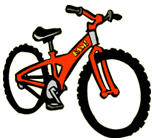BICYCLING ACTIVITY CARD
Parts of the Body Worked

Heart & Lungs

Upper & Lower Legs

Just what does it take to become a cyclist?
Gear Up
A Bike. Think of the type of riding you want to do before you buy one. Mountain bikes are strong and stable and built for gravel roads and tricky trails. Racing bikes are built to go super fast on pavement, and sport bikes, a combination of both, are good for many different purposes.
A Helmet. Your helmet should sit right above your eyebrows and be tightly buckled so it doesn’t slip while you are riding.
Play it Safe
Use your head and wear a helmet! You should always wear a helmet when you ride — plus, it’s the law in many states. It’s also important that your helmet is approved by one of the groups who test helmets to see which ones are the best: the Consumer Product Safety Commission (CPSC) or Snell B-95 standards are best for bicycling helmets. Try not to ride at night or in bad weather, and wear brightly colored, or reflective clothes whenever you ride so you can be seen. You can even put reflectors or funky reflective stickers on your bike — who knew being safe could look so cool? Also, watch out for loose pant legs and shoe laces that could get caught in your bike chain.
Be street smart. Ride on the right side of the road, moving with traffic, and obey all traffic signs and signals. Discuss the best riding routes with your parents — they’ll help you determine safe places to ride near your home.
When you reach an intersection, be sure to stop and look left, right, and then left again to check for cars — then go. Use hand signals to show when you’re going to turn, and be sure to keep an eye out for rough pavement ahead so you can avoid it. And although you may think you can’t go out without your favorite tunes, never wear headphones when you’re on your bike.
How to Play
Bicycling can be a great competitive sport, as well as a fun activity to do with your friends. And there are plenty of different types of bicycling depending on your personality. If you love to go fast-n-furious, bicycle racing is probably more your speed. If you like to hit the rocky road, mountain biking sounds more like your taste. And if you just like to pedal for pleasure, any kind of bicycling will do. Try riding to school or to a friend’s house!
Ology
The faster you are going, the longer it will take you to completely stop your bike once you hit the brakes. Science says that if you are going 20 MPH and you hit the brakes, it will take 15 feet to stop if you are on dry pavement, and 23 1/2 feet if you are on wet pavement, so make sure you brake early!
Fun Facts
100 calories can power a cyclist for 3 miles, but could only power a car for 280 feet.
In 1995, 50-year-old Fred Rompelberg set a new speed record for cycling at 166.9 mph.
Related Links
- Page last reviewed: May 9, 2015
- Page last updated: May 9, 2015
- Content source:



 ShareCompartir
ShareCompartir